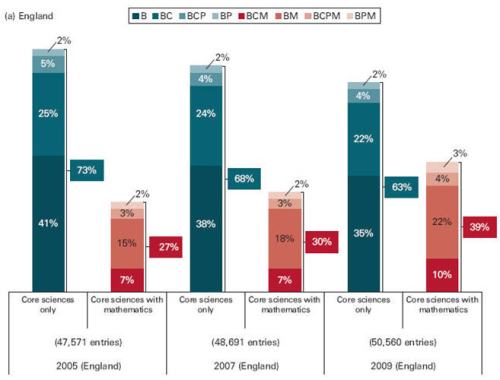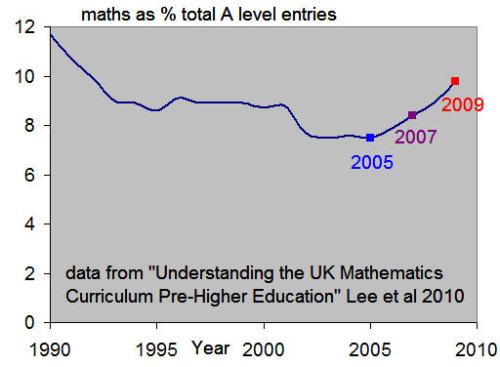There has been some discussion going around on various blogs/twitter following two recent publications: Michael Gove’s speech at the Royal Society about maths teaching and Stephen Curry’s article in the Times Higher about maths in bioscience degrees.
One particular comment struck a raw nerve with me and referred to “remedial teaching” of maths at university. Yes all of the maths I teach at first and second year university level for biological scientists and medics and vets is essentially GCSE and AS-level maths so let me explain why I don’t consider what I teach to be “remedial”.
The short answer is that I’m teaching the maths in a biological context, something which is clearly not done at school. In doing that I’m reinforcing what they have already learned and helping them to understand it at a deeper level (I hope!) I’m helping them to see its relevance and usefulness, again something that I’m not convinced is done at school.
All of my students will typically have three A’s at A level though not necessarily in A level maths: they are academically talented and pretty motivated in their studies. I find that some students have done maths A level and done pretty well but will quite openly admit that they didn’t really understand it properly. Others say that they’ve never been “good at maths” and didn’t dare to take it at A level because they’d have a better chance of getting their three A’s in other subjects.
There are some things university teachers take for granted that students have not covered at school. For example units (eg mg, min, ml) and how to use them in calculations. I guess some people might consider this akin to dimensional analysis. Students don’t typically include units in their calculations until I force them to. If they don’t then they end up with the wrong answer, usually by a factor of 1000 because they have forgotten a prefix or by 60 if they’ve mixed up seconds, minutes and hours. This isn’t “remedial” because it was never taught in the first place. Like most maths, it’s really obvious once you know it but completely obscure if you don’t.
A consequence of this is that it looks like they’re rubbish at maths, and they feel like they are, but they just need to be pushed into writing out their working and answers in a logical way that includes the units and most, if not all, of the steps. I guess this is also a symptom of rushing to get an answer instead of reflecting on what you’ve done and estimating whether the final answer is likely to be in the right ballpark.
Having worked with a number of dyslexics and dyspraxics now the importance of getting the maths onto the paper in a sensible, logical manner is often a stumbling block. I wonder how many non-dyslexics/dyspraxics this applies to too. For a multi-step problem it is essential to get the working out onto the page to relieve working memory but for many people it is hard to write in the mathematical language. They can often talk it through but not write it down. They clearly understand it but have difficulty communicating it. What I’m not sure about is how well the writing of mathematical working is taught at school. From where I sit it seems patchy, some students can do it ok whilst others don’t know where to begin.
Many mathematicians are so used to the language of maths that they cannot begin to understand how others cannot see what they see. I have seen lecturers in pharmacology present pharmacokinetics or receptor theory as a set of equations and expect students to look at the equation and see what the lecturer sees. If you put an equation on the board, even a simple one, students will typically not see or make sense of it in the way that the lecturer will.
At university we bemoan the difficulty students have with logarithms. However only those who have done AS level maths will have been taught about logarithms so it is wrong to call a course at university that covers logs a “remedial” course is wrong if they haven’t done it in the first place.
The most difficult part of maths within the life sciences is relating the maths to the biology. The number of times as a student myself I’ve been taken through the derivation of an equation and lost the plot is probably unmentionable. I have even fallen into the trap myself of thinking that if I just go through the algebra of deriving an equation (say the Michaelis Menton or the Schild equation) then students will understand the equation itself. It’s what you say as you do the derivation that’s important. It’s how you help them get an intuitive feel for the equation that makes the difference.
So how do you really get an intuitive feel for how an equation is used? My attitude at the moment is to abandon the lecture format and start with students solving problems themselves. My experience is that they really do know the maths but that they need time to absorb and develop the skills to be able to use it. There some nice initiatives going on: eg the TEAL project at MIT see also commentaries on pseudoteaching but as the article about the TEAL project points out, this sort of teaching is really very difficult, it takes time and resource to help the teachers develop the appropriate skills and it will often means that the teacher needs to change their own mindset.


